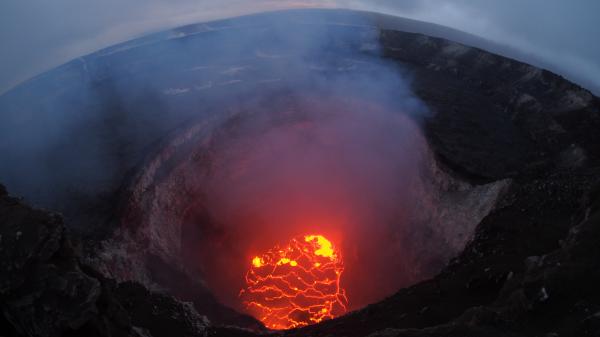
UPDATE May 12, 2018 from the Hawaiian Volcano Observatory/ USGS: Volcanic unrest in the lower East Rift Zone of K?lauea Volcano continues. While no lava has been emitted from any of the 15 fissure vents since May 9, earthquake activity, ground deformation, and continuing high emission rates of sulphur dioxide indicate additional outbreaks of lava are likely. The location of future outbreaks is not known with certainty, but could include areas both uprift (southwest) and downrift (northeast) of the existing fissures, or resumption of activity at existing fissures. Communities downslope of these fissures could be at risk from lava inundation.
On Wednesday – May 9, 2018 – the Hawaiian Volcano Observatory and USGS issued a second Orange Alert for Kilauea Volcano, which has been undergoing increased activity since late April, and whose flows of lava have already caused evacuations on Hawaii’s Big Island. This was not a raising of the alert level. An Orange Alert was already in place. The May 9 alert did, however, add the new information that:
The steady lowering of the lava lake in Overlook crater within Halema’uma’u at the summit of Kilauea Volcano has raised the potential for explosive eruptions in the coming weeks. If the lava column drops to the level of groundwater beneath Kilauea Caldera, influx of water into the conduit could cause steam-driven explosions. Debris expelled during such explosions could impact the area surrounding Halema’uma’u and the Kilauea summit. At this time, we cannot say with certainty that explosive activity will occur, how large the explosions could be, or how long such explosive activity could continue.
Residents of the Kilauea summit area should learn about the hazards of ashfall, stay informed of the status of the volcano and area closures, and review family and business emergency plans.
Resource on volcanic ash hazards: https://volcanoes.usgs.gov/volcanic_ash/
Remarks: HAZARDS
Primary hazards of concern should this activity occur are ballistic projectiles and ashfall.
BALLISTIC PROJECTILES
During steam-driven explosions, ballistic blocks up to 2 meters (yards) across could be thrown in all directions to a distance of 1 kilometer (0.6 miles) or more. These blocks could weigh a few kilograms (pounds) to several tons.
Smaller (pebble-size) rocks could be sent several kilometers (miles) from Halema’uma’u, mostly in a downwind direction.
ASHFALL
Presently, during the drawdown of the lava column, rockfalls from the steep enclosing walls of the Overlook crater vent impact the lake and produce small ash clouds. These clouds are very dilute and result in dustings of ash (particles smaller than 2 mm) downwind.
Should steam-driven explosions begin, ash clouds will rise to greater elevations above ground. Minor ashfall could occur over much wider areas, even up to several tens of miles from Halema’uma’u. In 1924, ash may have reached as high as 20,000 feet above sea level. Small amounts of fine ash from these explosions fell over a wide area as far north as North Hilo (Hakalau), in lower Puna, and as far south as Waiohinu.
GAS
Gas emitted during steam-drive explosions will be mainly steam, but will include some sulfur dioxide (SO2) as well. Currently, SO2 emissions remain elevated.
WARNING TIME
Steam-driven explosions at volcanoes typically provide very little warning. Once the lava level reaches the groundwater elevation, onset of continuous ashy plumes or a sequence of violent steam-driven explosions may be the first sign that activity of concern has commenced.
#HVO/#USGS Volcanic Activity Notice
for #Kilauea: Steady lowering of lava lake at summit of #KilaueaVolcano has raised potential for explosive eruptions in coming weeks. https://t.co/7sDZqcOJ5s @CivilDefenseHI will issue alerts if needed: https://t.co/uYm7YGqOmq #KilaueaErupts pic.twitter.com/2tPcrlxiZS— USGS Volcanoes? (@USGSVolcanoes) May 9, 2018
The HVO/USGS said that Kilauea’s lava lake began to drop on May 2, 2018. From its peak on May 2 to the most recent measurement at 9 p.m. on May 6, the lava lake surface dropped a total of more than 656 feet (200 meters). The scientists said:
The subsidence was at a relatively constant rate of about 2 meters (yards) per hour.
Measurements of subsidence have not been possible since May 6 because of thick fume and the increasing depth to the lava surface. However, thermal images indicate continued lowering of the lake surface since that time, consistent with deflationary tilt recorded at Kilauea’s summit. Therefore, we infer that the lake surface continues to drop at roughly the same rate. So, while HVO cannot report exact depths of the receding lava lake, we can monitor the overall trend.
USGS and HVO scientists says they are monitoring changes at the summit “24/7” and watching for signs that hazardous conditions have increased, or may increase.
Updates on activity will be posted on the HVO website at https://volcanoes.usgs.gov/volcanoes/kilauea/status.html
You can receive these updates by email through a free subscription service: https://volcanoes.usgs.gov/vns2/
Hawai‘i County Civil Defense will issue its own hazard notices should that become necessary: https://www.hawaiicounty.gov/active-alerts/
Hawai‘i Volcanoes National Park status is posted on their web page:
https://www.nps.gov/havo/index.htm
Resources on volcanic ash can be found at:
https://volcanoes.usgs.gov/volcanic_ash/
Daily updates on all volcanic activity at Kilauea are issued each morning and posted here: https://volcanoes.usgs.gov/volcanoes/kilauea/status.html
You can sign up to receive these messages automatically by visiting https://volcanoes.usgs.gov/vns2/
Rockfall generates a short-lived explosion at Halema‘uma‘u crater, Hawaii, at 8:27 a.m. HST, May 9. Explosion not caused by the interaction of the lava lake with the water table. https://t.co/hd8FPsBVgf pic.twitter.com/pNUcJYep9y
— USGS Volcanoes? (@USGSVolcanoes) May 9, 2018
Bottom line: The steady lowering of the lava lake in Overlook crater within Halema’uma’u at the summit of Kilauea Volcano has raised the potential for explosive eruptions in the coming weeks. If the lava column drops to the level of groundwater beneath Kilauea Caldera, influx of water into the conduit could cause steam-driven explosions.











